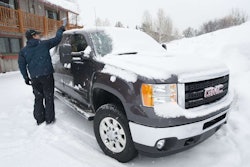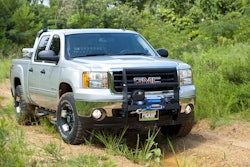 EYES IN THE SKY
EYES IN THE SKY
Today’s GPS tracking systems bring peace-of-mind and a boost in profits when you find the right vehicle tracking service for your fleet
By Amanda Bayhi
Vehicle tracking can come in handy for anyone who owns pickups or equipment.
Whether the fleet is small or large, vehicle tracking services can make management easier for drivers and owners alike.
GPS trackers can let an owner keep track of where each vehicle is at all times, ensure assets are being used properly, help conserve fuel, alert you to theft, act as a global positioning system (GPS), and these little electronic gems can even serve as a time clock.
For the single pickup owner, vehicle tracking can be a great help in preventing vehicle theft.
Deciding which tracking service to purchase depends on a number of things, including fleet size, number of drivers, areas of service and, of course, price and personal preferences.
Software vs. Web
While some service providers offer web- and software-based services, most only offer one or the other. Before you decide which to use, consider who will be using these services.
If only one person will use the services, software-based may be your best bet. Software services provide more security than web services because they can only be accessed from computers with the software installed.
The downside to software-only services is they usually only offer reports once the vehicle is back on site.
If several people need access to the tracking services, go web-based. Although the security isn’t as strong as software services, these web services have their perks. Anyone with the login information can access the services from any computer or smart phone with an internet connection. Plus, they offer real-time tracking which usually updates every 10 to 20 seconds.
Another point to note about web services is they may give the user capabilities to control certain parts of the vehicle from a computer.
U.S. Fleet Tracking, for example, allows a user to remotely lock and unlock doors, honk the horn, start the engine and disable and enable the starter. (We have had their trackers installed on both of our previous sweepstakes trucks, Big Boss and Super Crew.)
For companies looking to beef up security, these capabilities can be great tools to stop a theft after it’s happened.
Tracker Hardware
However, software isn’t the only component in vehicle tracking. You should also consider the hardware offered.
Some providers require customers to purchase the tracking hardware, while others have a rental option. If you decide to rent, you may be required to enter into a service contract in which you pay a monthly fee to use the tracking device.
The hardware is usually pricey (think $400 range), but if the fleet will need the services for an extended period of time, outright buying the device(s) will be a big money-saver.
Custom Interfaces
If you need the tracking services to work with other programs your company uses, you may want to look for services offering application-programming interface (API).
Some companies, such as GPS Insight, include API in their services to integrate the tracking software with another program, linking the two and allowing you to use both.
API can be useful for a number of reasons. When linked with Enterprise resource planning (ERP), tracking software can be used as a time sheet. When integrated with dispatch programs, it can save time and cut fuel costs.
If you want to make sure your vehicle doesn’t leave the job site, you’ll want to make sure the company offers geo-fencing.
Geo-fencing will allow you to set a virtual perimeter for any vehicles being tracked. If a vehicle leaves the perimeter, say within the confines of a remote jobsite or off your company’s property, it will trigger an alarm.
You can specify a type of alert—usually either text message or email—for when this happens. This allows you or whoever is monitoring the tracking system to take the appropriate actions.
Another offering to look for when choosing your vehicle tracking system is the availability of “historical data reports.” Most companies, particularly software-based, include this for free with their services.
Historical data reports can be used for a number of purposes. You can use them as time cards to be sure your employees are being honest about when they work and where they take your vehicle. They can also be used as a receipt for customer service, or to analyze routes to minimize overlaps and travel time.
Most importantly, they can help you keep an eye on what your employees are doing on the clock so you aren’t paying them to do anything other than work.
One GPS Insight customer reported improvements because of services such as historical reports.
“The first week we installed GPS Insight, we caught three separate technicians inflating their field reports,” said Dan Zaharoni of Cal Building & Maintenance Industries. “The average number of hours paid for each of our technicians decreased… However, work performed by the same technicians actually increased since they were forced to be accountable for each minute of their day.”
Cost of Coverage
Probably the most important factor to managers looking for fleet-tracking options is the price.
Most providers require you to purchase the hardware from them. Prices for hardware usually range anywhere from $200 to $500. The cost may depend on features offered, installation or a number of other factors.
When purchasing vehicle tracking, you will almost always have to pay a monthly service fee that’s around $30 per vehicle. Some providers require customers to sign a contract on a month-to-month basis while other providers may require a longer contract.
Vehicle tracking offers a lot of features to consider from software and web to hardware and costs. But when it’s time to make a decision, it’s all about what’s best for you company and your fleet.
Vehicle Tracking Terms To Know
- Active services collect data from the vehicle and track it in real time, usually using a satellite. The data can often be viewed immediately from any computer or smart phone.
- API, or application programming interface, allows two programs to interact. In vehicle tracking, this means your software can be connected with other programs your company uses, such as ERP, dispatching and CRM, to help you cut fuel and vehicle service costs while remotely managing your drivers.
- Geo-fencing helps keep your vehicle in a virtual perimeter. If the vehicle leaves this perimeter, you will be alerted, often by short message service (SMS)—more commonly known as a text message—or by email. It’s a good way to prevent vehicle and asset theft.
- GPS, or global positioning system, is a U.S. government-owned satellite system located in space which can track anything on earth and send the information it collects. Vehicle tracking services use GPS to locate and track vehicles and assets.
- Historical data shows you everything the vehicle has done since it left the office, including routes it took as well as its speed throughout the trip.
- Passive services store data internally, which can be reviewed once the vehicle returns to the office. This is often used to track historical data.
- Real-time updates allow you to see what’s going on with your vehicle within seconds of when it occurs by watching an icon of the vehicle on your computer or phone screen. Most service providers give real-time updates of five to 10 seconds, but some may take up to one or two minutes.
Product Showcase
See images below.







